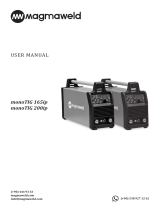
EN
www.magmaweld.com
Monotig 160i Basic 9
USER MANUAL | KULLANIM KILAVUZU
Accordng to artcle 5.2 of IEC 60974-9;
Before installing the welding and cutting equipment, the person in charge of the operation and/or the
user must conduct an inspection of possible electromagnetic interference in the environment. Aspects
indicated below has to be taken into consideration;
a) Other supply cables, control cables, signal and telephone cables, above and below the welding
machine and its equipment,
b) Radio and television transmitters and receivers,
c) Computer and other control hardware,
d) Critical safety equipment, e.g. protection of industrial equipment,
e) Medical apparatus for people in the vicinity, e.g. pacemakers and hearing aids,
f) Equipment used for measuring or calibration,
g) Immunity of other equipment in the environment. The user must ensure that the other equipment in
use in the environment is compatible. This may require additional protection measures.
h) Considering the time during which the welding operations or other activities take place during the
day, the boundaries of the investigation area can be expanded according to the size of the building,
the structure of the building and other activities that are being performed in the building.
In addition to the evaluation of the field, evaluation of device installations may also be necessary for
solving the interfering eect.
In case if deemed necessary, on-site measurements can also be used to confirm the eiciency of
mitigation measures. (Source: IEC 60974-9).
• The appliance must be connected to the electricity supply in the recommended manner by a
competent person. If interference occurs, additional measures may be applied, such as filtering the
network.
The supply of the fixed-mounted arc welding equipment must be made in a metal tube or with an
equivalent shielded cable. The housing of the power supply must be connected and a good electrical
contact between these two structures has to be provided.
• The recommended routine maintenance of the appliance must be carried out. All covers on the body
of the machine must be closed and/or locked when the device is in use. Any changes, other than the
standard settings without the written approval of the manufacturer, cannot be modified on the
appliance. Otherwise, the user is responsible for any consequences that may possibly occur.
• Welding cables should be kept as short as possible. They must move along the oor of the work area,
in a side by side manner. Welding cables should not be wound in any way.
• A magnetic field is generated on the machine during welding. This may cause the machine to pull
metal parts on to itself. To avoid this attraction, make sure that the metal materials are at a safe
distance or fixed. The operator must be insulated from all these interconnected metal materials.
• In cases where the workpiece cannot be connected to the ground due to electrical safety, or because
of its size and position (for example, in building marine vessel bodies or in steel construction
manufacturing), a connection between the workpiece and the grounding may reduce emissions in
some cases, it should be kept in mind that grounding of the workpiece may cause users to sustain
injuries or other electrical equipment in the environment to break down. In cases where necessary,
the workpiece and the grounding connection can be made as a direct connection, but in some
countries where direct connection is not permissible, the connection can be established using
appropriate capacity elements in accordance with local regulations and ordinances.
• Screening and shielding of other devices and cables in the work area can prevent aliasing eects.
Screening of the entire welding area can be evaluated for some specific applications.
Evaluation Of Electromagnetic
Suitability Of The
Work Area
Electromagnetic Interferance
Reduction Methods
Safety Precautions

























